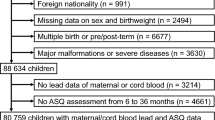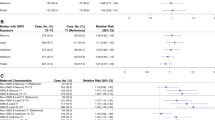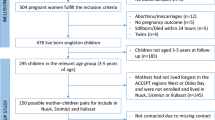Abstract
Aims: The primary focus of this exposure assessment work involved developing an exposure model and determining a numerical point estimate of the amount of biologically relevant nitrate/nitrite exposure that occurred for each child in the study. This assessment was done in support of two epidemiological studies. The first study was an epidemiological cohort study (three cohorts based on nitrate/nitrite exposure) that explored the relationship between high nitrate/nitrite exposure and neuropsychological development. The second study was a nested case/control study (cases of methemoglobinemia versus disease-free controls) that sought to explore the relationship between MHG and various risk factors for the disease. Methods: This work uses both dietary survey and environmental sampling and modeling in order to develop two point estimates of nitrate exposure in milligrams per kilogram per day of nitrite (the biologically active form of the hemoglobin-oxidizing agent) for the first 6 months of the child's life (2-months-of-age and 6-months-of-age point estimates). Methodologies included proxy interviews of primary caregivers, review of existing medical and environmental sampling and analysis. Results: Exposure to nitrate–nitrogen (with final calculations converted to the biologically active form of the toxin, nitrite) was categorized as high, medium, and low as determined from the distribution of the data derived from final exposure calculations at both the 2-months-of-age point estimate and at the 6-months-of-age point estimate. These tertiles correspond to ≥1.5 mg/kg/day nitrite–nitrogen for high-exposure individuals, <1.5–≥0.1 mg/kg/day for medium-exposure individuals, and <0.1 mg/kg/day for low-exposure individuals. Analyses illustrate that over 90% of the nitrate exposure occurred through the consumption of liquids (water) at the 2-months-of-age point estimate while at the 6-months-of-age point estimate, a 10-fold change in the amount of solid consumables occurred. Conclusions: Final exposure calculations were well differentiated into three tertiles based on a point estimate of average daily intake of nitrite in milligrams per kilogram body weight per day at roughly 2 and 6 months of age. These categories of exposure, based on the exposure model point estimate, correspond well with the exposure estimates as estimated only on the basis of cohort status and their corresponding nitrate/nitrite well water levels. Comparisons of these two sets of data illustrate that following the MHG incident, Cohort II shifted places with Cohort I to become the high-exposure cohort. Further, the predictive ability of the exposure assessment in regard to the outcome of MHG was estimated using a Likelihood Ratio and Pearson's Crosstab analysis. This was performed on the 2-month-of-age point estimate. Likelihood Ratio and Pearson's chi-square were 39.40 and 33.74, respectively, with a probability of achieving these fits by chance alone of <0.0001. This indicates clearly that the children who experienced MHG were also the children at the 2-month-of-age point estimate who had received the highest exposure to nitrate/nitrite through their diet.
This is a preview of subscription content, access via your institution
Access options
Subscribe to this journal
Receive 6 print issues and online access
$259.00 per year
only $43.17 per issue
Buy this article
- Purchase on Springer Link
- Instant access to full article PDF
Prices may be subject to local taxes which are calculated during checkout




Similar content being viewed by others
References
Armstrong B (1995). Study design for exposure assessment in epidemiological studies, Sci Total Environ. 168(2): 187–194
Avery A, 1999. Infantile methemoglobinemia: reexamining the role of drinking water nitrates, Environ Health Perspect. 107(7): 583–586
Ayebo A Kross BC Vlad M Sinca A, 1997. Infant methemoglobinemia in the Transylvania Region of Romania, Int J Occup Environ Health. 3(1): 20–29
Aylward GP, 1990. Environmental influences on the developmental outcome of children at risk, Infants Young Child. 2(4): 1–9
Aylward GP, 1993. Perinatal asphyxia: effect of biologic and environmental risks, Clin Perinatol. 20(2): 433–449
Aylward GP Verhulst SJ Bell S, 1989. Correlating of asphyxia and other risk factors with outcome: a contemporary view, Dev Med Child Neurol. 31: 329–340
Baranowski T, 1991. Accuracy of maternal dietary recall for preschool children, J Am Diet Assoc. 91(6): 669–674
Bartholomew B Hill MJ, 1984. The pharmacology of dietary nitrate and the origin of urinary nitrate, Educ Chem Toxicol. 22(10): 789–795
Bearer CF, 1995 Environmental health hazards: how children are different from adults. The Future of Children web site Available at: www.futureofchildren.org/cri/02cri.htm
Borawska M Markiewicz R Omiljaniuk N Witkowska A Jurkian A Krzesiewics J, 1996. The nitrate and nitrite contents in a whole day's hospital diet during the spring season, Rocz Akad Med Bialymstoku. 41(2): 22–209
Bradburn NM Rips LJ Shevell SK, 1997. Answering autobiographical questions: the impact of memory and inference on surveys, Science. 236: 157–161
Cingi MI Cingi C Cingi E, 1992. Influence of dietary nitrate on nitrite level of human saliva, Bull Environ Contam Toxicol. 48(1): 83–88
Coggon D, 1993. Questionnaire based exposure assessment methods, Sci Total Environ. 168(2): 175–178
Cox JD Harrop D Head AJ, 1979. The standard enthalpy of formation of ammonium nitrate and of the nitrate ion, J Chem Thermodyn. 2(11): 811–814
Czarnicka E Kowalska K Zalewski S, 1995. Effect of cooking methods on vitamin C, nitrates and nitrites contents and sensory quality in brussels sprovis, Pol J Food Nutr Sci. 2(43): 85–92
Dalefield R Ochme F, 1997. Stability of water nitrate levels during prolonged boiling, Vet Hum Toxicol. 39(5): 303
Davis H Kim B Johnston H Lee YT, 1993. Dissociation energy and photochemistry of NO 3, J Phys Chem. 97(10): 2172–2180
Dewey KG, 1998. Cross-cultural patterns of growth and nutritional status of breastfed infants, Am J Clin Nutr. 67: 10–17
Ellis G Adatia I Yazdanpanah M Makela S, 1998. Nitrite and nitrate analyses: a clinical biochemistry perspective, Clin Biochem. 31(4): 195–220
Environmental Protection Agency (EPA) 1988. Proposed guidelines for exposure-related measurements, Fed Regist. 53(232): 48830–48853 FRL-3484-8
Environmental Protection Agency (EPA) 1997 Exposure Factors Handbook, vols. I, II, III. Office of Research and Development, Washington, DC
Environmental Protection Agency (EPA) 1995 An SAB report: Human exposure assesment: A guide to risk ranking, risk reduction and research planning. U.S. Environmental Protection Agency, Washington DC
Fritsch P Saint Blanquant G, 1992. Nitrates and nitrites: food intake and fate, Sci Aliments. 12: 563–578
Greenberg AE Clesceri EE Eaton D (Eds.) 1992 Standard Methods for the Examination of Water and Wastewater, 18th edn. EPS Group, Hanover, MD
Greenberg RS Daniels SR Flanders WD Eley JW Boring JR, 1996 Medical Epidemiology, 2nd edn. Appleton and Lange, Stamford, CT
Hartman PE, 1982 Nitrates and nitrites: ingestion, pharmacodynamics, and toxicology In: de Serres F.I., and Hollaender A. (Eds.). Chemical Mutagens — Principles and Methods for Their Detection Plenum, New York 211–260
Huarte-Mendicoa JC Astiasuran J Bello J, 1996. Nitrate and nitrite levels in fresh and frozen broccoli: Effect of freezing and cooking, Food Chem. 58(1): 39–42
Johnson CJ Kross BC, 1990. Continuing importance of nitrate contamination of groundwater and wells in rural areas, Am J Ind Med. 18: 449–456
Johnson CJ Bonrud PA Dosch TL et al 1987. Fatal outcome of methemoglobinemia in an infant, JAMA, J Am Med Assoc. 257(20): 2796–2797
Klaassen CD (Ed.) 1996 Casarett and Doull's Toxicology, The Basic Science of Poisons, 5th edn. McGraw-Hill, New York
Kross BC Ayebo AD, 1991 Nitrate/Nitrite Toxicity In: Hall, A. (Guest Ed.). Toxic Substances and Disease Registry 1–24
Kross BC Ayebo AD Fuortes LJ, 1992. Methemoglobinemia: nitrate toxicity in rural America, Am Fam Physician. 46(1): 183–188
Kross BC Hallberg GR Bruner R Cherryholmes K Johnson JK, 1993. The nitrate contamination of private well water in Iowa, Am J Public Health. 83(2): 270–272
Kross BC Harper D Sinca A et al 1996 Infant methemoglobinemia in rural Transylvania (Romania). Funded grant, unpublished manuscript. Department of Preventive Medicine, University of Iowa, Iowa City
Lenkova K Vargova M, 1994. Hazardous wastes in the Slovak Republic — a national report, Cent Eur J Public Health Suppl. 2 43–48
Levy PS Lemeshow S, 1999 Sampling of populations, methods and applications, 3rd edn. Wiley-Interscience, New York, NY
Liedtke MA Meloan CE, 1976. Rapid screening determination of nitrate in baby food using the nitrate-selective electrode, J Agric Food Chem. 24(2): 410–412
Livingstone MBE, 1992. Validation of estimates of energy intake by weighed dietary record and dietary history in children and adolescents, Am J Clin Nutr. 56(1): 29–35
Markel E Nyakas C Ormai S, 1989. Nitrate induced changes in sensorimotor development and learning behavior in rats, Acta Physiol Hung. 74(1): 69–75
Mbanugo JI Sridhar MKC Anunuso CI, 1990. Methemoglobin levels in infants receiving low dietary nitrates in Eastern Nigeria, Toxicol Environ Chem. 25: 195–199
Meah MN Harrison N Davies A, 1994. Nitrate and nitrite in foods and the diet, Food Addit Contam. 11(4): 519–532
Meyer M, 1996. How common is methemoglobinemia from nitrate contaminated wells?, Water Cond Purif March 78–81
National Research Council 1987. Biological markers in environmental health research, Environ Health Perspect. 74: 3–9
Petersen BJ Barraj LM Muenz LR Harrison SL, 1994. An alternative approach to dietary exposure assessment, Risk Anal. 14(6): 913–916
Petukhov NI Ivanov AV, 1970. Investigation of certain psycho-physiological reactions in children suffering from methemoglobinemia due to nitrates in water, Hyg Sanit. 35(1): 29–31
Steenland K Deddens JA, 1997 Design and analysis of studies in environmental epidemiology In: Steenland K., and Savitz D.A. (Eds.). Topics in Environmental EpidemiologyOxford Univ. Press, New York, NY 9–27
Stolwijk JAJ, 1995. Exposure assessment needs in studies of delayed health effects, Sci Total Environ. 168(2): 119–122
Taylor HG Albo VC Thebus CK Sachs BR Bierl PG, 1987. Post-irradiation treatment outcomes for children with acute lymphocytic leukemia: clarification of risks, J Pediatr Psychol. 12(3): 395–411
Trnovec T Kross BC Ginter E, 1996. Perspectives on rural environmental health in Central Europe, Int J Occup Environ Health. 2(2): 125–134
Vitousek PM Aber JD Howard RW et al 1997. Human alteration of the global nitrogen cycle sources and consequences, Ecol Appl. 7(3): 737–750
Vitozzi L, 1992. Toxicology of nitrates and nitrites, Food Addit Contam. 9(5): 579–585
Viveiros DM Tondat LM, 1978. Effects of sodium nitrite on DRL performance in the rat, Pharmacol, Biochem Behavior. 8(2): 125–127
Vlad M Unpublished manuscripts and data files. Obtained during cooperative fieldwork with the Institutes of Public Health, Cluj Napoca, Romania, June (1997)
Vlad M Personal conversation. Environmental and developmental issues in the identification and prevention of methemoglobinemia in Romanian infants. A workshop held in Satu Mare, Romania, October 19–21, 1999
Wagner DA Schultz DS Deen WD Yang VR Tannumbaum SR, 1983. Metabolic rate of an oral dose of 15N-labeled nitrate in humans. Effect of diet supplementation with ascorbic acid, Cancer Res. 43: 1921–1925
Walker R, 1990. Nitrates, nitrites and N-nitroso compounds: a review of the occurrence in food and diet and the toxicological implications, Food Addit Contam. 7(6): 717–768
Wieczorek C Motyka M Picka W Zalewski S, 1994. Effect of culinary procesors on nitrate, nitrite and carotenoids content in carrot, Pol J Food Nutr Sci. 3194(3): 137
Author information
Authors and Affiliations
Corresponding author
Rights and permissions
About this article
Cite this article
ZEMAN, C., VLAD, M. & KROSS, B. Exposure methodology and findings for dietary nitrate exposures in children of Transylvania, Romania. J Expo Sci Environ Epidemiol 12, 54–63 (2002). https://doi.org/10.1038/sj.jea.7500202
Received:
Published:
Issue Date:
DOI: https://doi.org/10.1038/sj.jea.7500202



